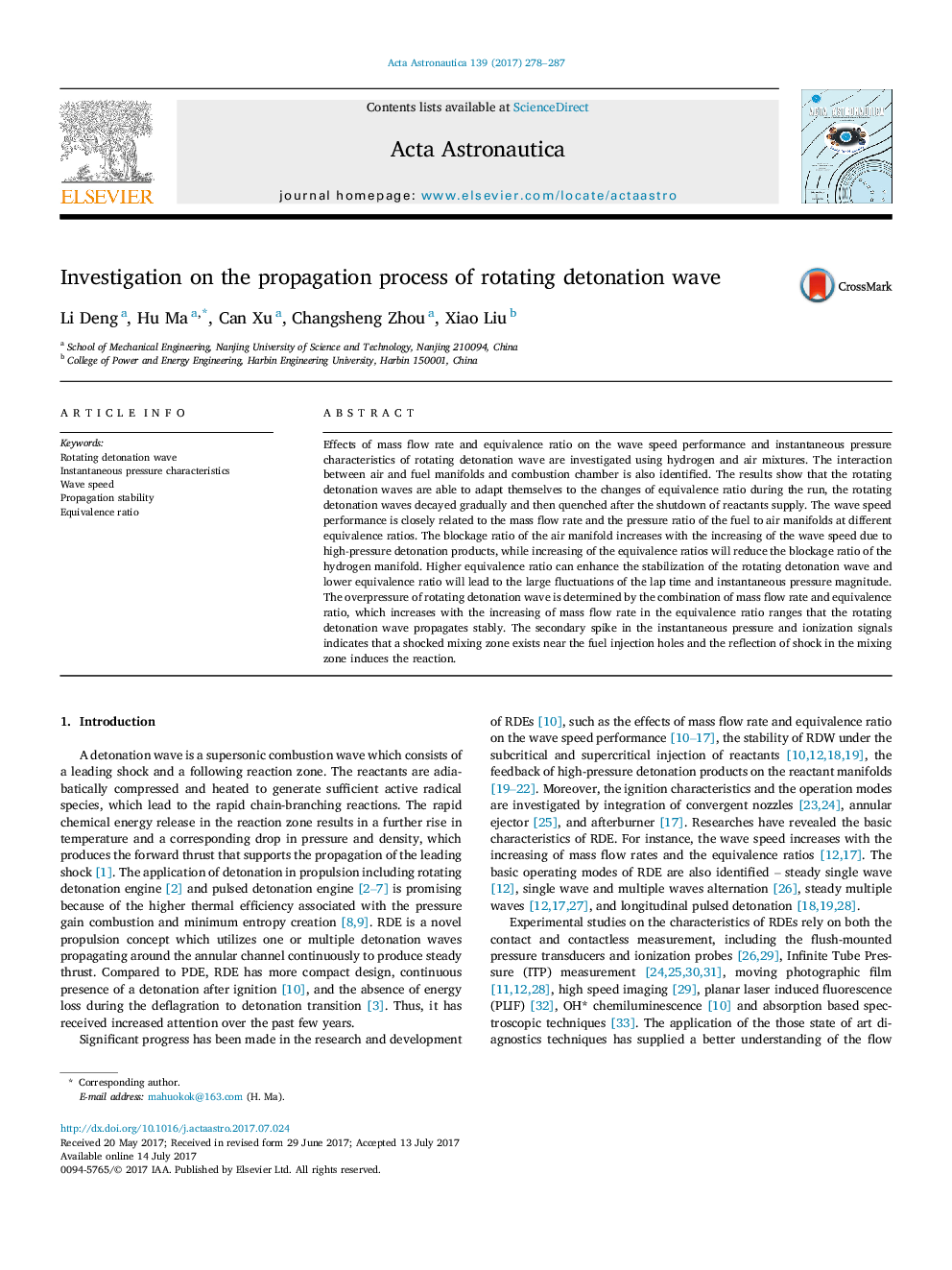| کد مقاله | کد نشریه | سال انتشار | مقاله انگلیسی | نسخه تمام متن |
|---|---|---|---|---|
| 5472271 | 1519915 | 2017 | 10 صفحه PDF | دانلود رایگان |
عنوان انگلیسی مقاله ISI
Investigation on the propagation process of rotating detonation wave
ترجمه فارسی عنوان
بررسی روند انتشار موج چرخش موج انفجاری
دانلود مقاله + سفارش ترجمه
دانلود مقاله ISI انگلیسی
رایگان برای ایرانیان
کلمات کلیدی
چرخش موج انفجار، خصوصیات لحظه ای سرعت موج، ثبات انتشار، نسبت معادل،
ترجمه چکیده
اثر جریان جرم جرم و نسبت هم ارزی بر عملکرد موج موج و ویژگی های فشار لحظه ای موج موج انفجاری چرخان با استفاده از مخلوط های هیدروژن و هوا مورد بررسی قرار می گیرد. تعامل بین منیفولد های هوا و سوخت و اتاق احتراق نیز شناسایی شده است. نتایج نشان می دهد که امواج انفجاری چرخشی قادر به خود سازگاری با تغییرات نسبت هم ارز در طول اجرای هستند، موج های انفجاری چرخشی به تدریج فرو می روند و بعد از خاموش شدن واکنش دهنده ها فرو می روند. عملکرد موج موج نزدیک به سرعت جرم جرم و نسبت فشار هوا به مایع های هوا در نسبت های مختلف هم ارز مربوط می شود. نسبت انسداد منیفولد هوا با افزایش سرعت موج به علت محصولات انفجاری فشار بالا افزایش می یابد، در حالیکه افزایش نسبت مساوی باعث کاهش نسبت انسداد منیفولد هیدروژن می شود. نسبت متعادل بالاتر می تواند ثبات موج موج انفصالی را افزایش دهد و نسبت پایین تر همرنگی به نوسان های بزرگ زمان لبه و فشار فشار لحظه ای منجر شود. بیش از حد موج موج انفجاری چرخانده شده بوسیله ترکیب جرم جرمی و نسبت هم ارز تعیین می شود که با افزایش جریان جرم در مقادیر نسبت همجوشی افزایش می یابد که موج انفجار چرخش ثابت می شود. سنسور ثانویه در سیگنال های لحظه ای و یونیزاسیون نشان می دهد که یک منطقه مخلوط شوک وجود دارد در نزدیکی حفره های تزریق سوخت و انعکاس شوک در منطقه مخلوط باعث واکنش می شود.
موضوعات مرتبط
مهندسی و علوم پایه
سایر رشته های مهندسی
مهندسی هوافضا
چکیده انگلیسی
Effects of mass flow rate and equivalence ratio on the wave speed performance and instantaneous pressure characteristics of rotating detonation wave are investigated using hydrogen and air mixtures. The interaction between air and fuel manifolds and combustion chamber is also identified. The results show that the rotating detonation waves are able to adapt themselves to the changes of equivalence ratio during the run, the rotating detonation waves decayed gradually and then quenched after the shutdown of reactants supply. The wave speed performance is closely related to the mass flow rate and the pressure ratio of the fuel to air manifolds at different equivalence ratios. The blockage ratio of the air manifold increases with the increasing of the wave speed due to high-pressure detonation products, while increasing of the equivalence ratios will reduce the blockage ratio of the hydrogen manifold. Higher equivalence ratio can enhance the stabilization of the rotating detonation wave and lower equivalence ratio will lead to the large fluctuations of the lap time and instantaneous pressure magnitude. The overpressure of rotating detonation wave is determined by the combination of mass flow rate and equivalence ratio, which increases with the increasing of mass flow rate in the equivalence ratio ranges that the rotating detonation wave propagates stably. The secondary spike in the instantaneous pressure and ionization signals indicates that a shocked mixing zone exists near the fuel injection holes and the reflection of shock in the mixing zone induces the reaction.
ناشر
Database: Elsevier - ScienceDirect (ساینس دایرکت)
Journal: Acta Astronautica - Volume 139, October 2017, Pages 278-287
Journal: Acta Astronautica - Volume 139, October 2017, Pages 278-287
نویسندگان
Li Deng, Hu Ma, Can Xu, Changsheng Zhou, Xiao Liu,
